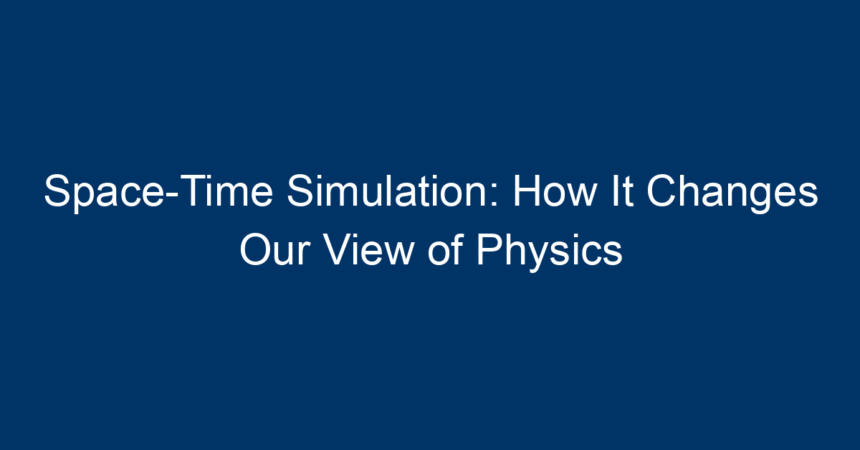Introduction
In the realm of modern physics, few concepts are as intriguing as the idea of a space-time simulation. This groundbreaking approach merges physics with advanced computational techniques, allowing scientists to explore the fundamental laws of the universe in ways previously thought impossible. But what exactly is a space-time simulation, and how does it reshape our understanding of everything from black holes to the age of the universe? This article delves into the essence of space-time simulations, examining their methodologies, implications, and the revolutionary changes they bring to our perception of physics.
Understanding Space-Time: The Basics
Before we explore space-time simulations, it’s crucial to establish a foundational understanding of space-time itself. Formulated by Albert Einstein, this concept combines the three dimensions of space with the dimension of time into a single four-dimensional continuum.
The Four Dimensions
- Length
- Width
- Height
- Time
In this framework, objects are not merely positioned in space but also in time, emphasizing that events occur at specific points in this four-dimensional construct.
The Significance of Space-Time in Physics
Space-time serves as the backdrop for all physical events. Its curvature, influenced by mass and energy, results in the gravitational forces we observe. This revolutionary approach reshaped our understanding of gravity, electromagnetism, and even the formation of the cosmos.
What is a Space-Time Simulation?
A space-time simulation uses mathematical models and computer algorithms to visualize and manipulate the complexities of the universe as it relates to space and time. By creating virtual environments where the laws of physics can be manipulated and studied, researchers can gain new insights into the nature of reality.
Simulation Techniques
-
Numerical Relativity: This technique employs complex algorithms to solve Einstein’s field equations, elucidating how gravitational waves and black holes interact.
-
Quantum Simulations: These address quantum mechanics and can model particle interactions and wave functions, leading to a deeper understanding of the quantum universe.
- Cosmic Simulations: Used in cosmology, these simulations model the evolution of large-scale structures in the universe, from galaxies to cosmic microwave background radiation.
The Technology Behind Space-Time Simulations
Creating effective space-time simulations requires advanced technologies, including:
High-Performance Computing
Modern simulations utilize supercomputers capable of performing trillions of calculations per second. This computational power is essential for solving complex equations that define the behavior of matter and energy in space-time.
Visual Rendering
With the aid of cutting-edge visual rendering technologies, scientists can create stunning visualizations, making it easier to grasp intricate concepts. These visualizations transform abstract equations into tangible representations of phenomena like black hole collisions or the expansion of the universe.
Implications of Space-Time Simulations
The advent of space-time simulations carries profound implications for various fields of physics.
Revolutionizing Cosmology
Space-time simulations have the potential to answer fundamental questions in cosmology, such as:
- What is dark matter?
- How did the universe evolve post-Big Bang?
By simulating the cosmos, researchers can test theories against virtual environments, improving their understanding of the universe’s architecture.
Advancements in Quantum Physics
In quantum physics, space-time simulations serve as laboratories for testing the intricacies of subatomic behavior. They provide insights into phenomena like quantum entanglement, particle interactions, and the unification of forces.
Understanding Black Holes
Simulations allow physicists to explore the complex dynamics of black holes, shedding light on how they distort space and time. These models help refine predictions about gravitational waves and may even lead to new theories regarding the universe’s fate.
Case Studies: Notable Space-Time Simulations
Several landmark projects exemplify the power of space-time simulations:
LIGO and Gravitational Waves
The Laser Interferometer Gravitational-Wave Observatory (LIGO) utilizes simulations to predict gravitational wave signals produced by merging black holes. These predictions help scientists confirm the existence of gravitational waves and further our understanding of cosmic phenomena.
The Illustris Project
This ambitious simulation project models the formation and evolution of galaxies under the influence of gravity, dark matter, and gas. It generated detailed visualizations that have reshaped our understanding of galaxy formation and distribution in the cosmos.
Black Hole Merger Simulations
Research teams have created simulations that visualize and analyze black hole mergers, providing crucial data about the emitted gravitational waves and expanding our knowledge of these enigmatic objects.
The Future of Space-Time Simulations
As technology continues to evolve, the future of space-time simulations looks promising. With advancements in artificial intelligence and machine learning, simulations may become even more accurate and efficient. This progress could lead to breakthroughs in understanding chaotic systems, enhancing our knowledge of everything from the fundamental particles that compose matter to the large-scale structure of the universe.
Integrating AI
Integrating artificial intelligence into space-time simulation techniques could lead to real-time predictive analytics, offering physicists a dynamic tool for understanding complex systems. AI could help identify new patterns and anomalies that human researchers might overlook.
Citizen Science
Advancements in user-friendly simulation software could open doors for amateur astronomers and physics enthusiasts to contribute to space-time simulations. This democratization of technology could inspire a new generation of scientists passionate about uncovering the mysteries of the universe.
Conclusion: Embracing the Future of Physics
In conclusion, space-time simulation is not just a scientific curiosity but a revolutionary approach that fundamentally alters how we view physics. By combining high-performance computing with advanced visualization techniques, space-time simulations provide insights that can redefine our understanding of gravity, quantum mechanics, and the universe at large.
Actionable Insights
-
Get Involved: Stay informed about ongoing research and consider participating in citizen science projects that focus on space-time simulations.
-
Expand Your Knowledge: Explore online courses in computational physics or numerical relativity to understand the mechanics behind these simulations.
- Engage with Communities: Join online forums or local groups interested in astrophysics and simulations to share knowledge and learn from others.
By embracing the science of space-time simulations, we not only enhance our grasp of the cosmos but also stimulate a collective curiosity that propels humanity towards a more profound understanding of existence itself.




